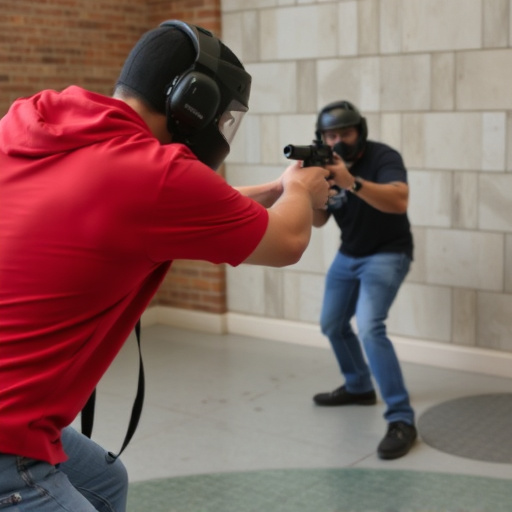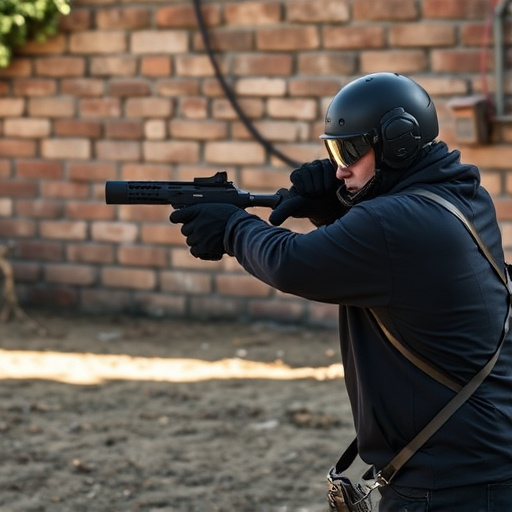Stun guns, or electroshock weapons, temporarily incapacitate targets with high-voltage electrical pulses, but carry potential neurological side effects like muscle contractions and cardiac arrhythmias. Their effectiveness is influenced by user skill, environmental conditions, and projectile type. Global legal status varies, with many regions imposing strict regulations due to adverse health effects. Safe use requires proper training, focusing on range, activation, and de-escalation techniques to mitigate risks while maintaining public safety during high-risk situations like active shooters or violent criminals.
“Discover the powerful capabilities of stun weapons, focusing on their projectile range and precision. This comprehensive guide explores the inner workings of stun guns and their impact. From the science behind their neurological side effects to legal considerations and real-world applications, we delve into the factors influencing accuracy. Learn about safety precautions, training protocols, and case studies highlighting the role of stun weapons in modern law enforcement. Understand the mechanisms, limitations, and potential risks associated with these non-lethal force tools.”
- Stun Gun Operation and Mechanism
- Projectile Range: Factors Influencing Accuracy
- The Science Behind Neurological Side Effects
- Legal Considerations and Regulations
- Safety Precautions and Training
- Real-World Applications and Case Studies
Stun Gun Operation and Mechanism

Stun guns, also known as electroshock weapons, operate by delivering a powerful electric shock to temporarily incapacitate a target. When activated, these devices emit a high-voltage, low-current electrical pulse through two probes or electrodes. This electric current interferes with the brain’s neural signals, causing muscles to contract uncontrollably and leading to a state of temporary paralysis or disorientation in the victim. The effect is designed to stun and subdue an individual without causing permanent harm, though it can result in significant neurological side effects.
The mechanism behind stun guns is based on the principle of electrical disruption. The probes make contact with the target’s body, typically the limbs or torso, and the electric current travels through the body, disrupting nerve impulses and muscle control. This rapid and intense stimulus overloads the nervous system, leading to a brief but powerful incapacitation. The range of these weapons varies depending on factors like battery life, power output, and atmospheric conditions, but they are generally designed for short-range applications, typically up to 2–3 meters (6–10 feet), ensuring safety and minimizing collateral damage while providing an effective means of self-defense or law enforcement control.
Projectile Range: Factors Influencing Accuracy

The accuracy of a stun weapon’s projectile range is significantly influenced by various factors, which are crucial in determining its effectiveness and potential neurological side effects. The primary consideration is the user’s skill and training; proper technique ensures the stun gun’s electric current connects with the target, neutralizing them without causing severe harm. Range also depends on environmental conditions, such as temperature, humidity, and wind speed, which can affect the flight of the projectile.
Another critical aspect is the type of ammunition used. Stun weapons employ specialized projectiles designed to maximize contact area and electrical delivery. Factors like projectile weight, shape, and surface area play a role in achieving the desired stun effect while minimizing collateral damage. Understanding these variables is essential for responsible stun weapon usage, ensuring public safety, and mitigating potential neurological side effects associated with excessive or inappropriate use.
The Science Behind Neurological Side Effects

Stun weapons, including stun guns and tasers, operate by delivering an electric current to the target’s nervous system, disrupting their motor functions and causing temporary incapacitation. This disruption is primarily achieved through targeting specific nerve pathways in the body. The intensity of this electrical pulse can vary greatly among different stun devices, with each manufacturer claiming unique levels of effectiveness within specified range capabilities. However, it’s crucial to understand that these weapons are not without potential neurological side effects.
The electric current generated by stun guns affects the target’s nervous system in several ways. Short-term effects may include muscle contractions, disorientation, and temporary paralysis. More severe reactions can lead to breathing difficulties, loss of consciousness, and even cardiac arrhythmias. While these symptoms are typically temporary, repeated or prolonged exposure to electrical shocks from stun weapons could potentially have long-lasting neurological impacts. Studies suggest that chronic exposure to high-voltage shocks may contribute to nerve damage, memory impairment, and other cognitive issues. Thus, understanding the neurological side effects of stun guns is vital in ensuring their responsible use.
Legal Considerations and Regulations

The legal landscape surrounding stun weapons, also known as electroshock guns, varies significantly across different jurisdictions. It’s crucial to understand that while these devices can provide a non-lethal means of self-defense, their use is heavily regulated due to potential neurological side effects. Many countries and states have strict laws dictating who can possess, carry, and deploy stun weapons, often requiring permits or specialized training.
Regulations also outline the specific circumstances under which stun guns can be employed legally, such as for personal protection or by law enforcement. Moreover, there are restrictions on the power output allowed in civilian-use models to prevent unnecessary harm while still ensuring effectiveness. Despite these measures, controversies persist due to concerns over misuse and potential adverse effects on individuals’ neurological health, underlining the need for continued discussion and refinement of stun weapon regulations.
Safety Precautions and Training

When considering stun weapon projectile range capabilities, it’s crucial to prioritize safety precautions and proper training. Stun guns, while effective in neutralizing targets, can cause significant neurological side effects if not used correctly. Misuse or inadequate training could lead to serious injuries or even death, as the electrical current can disrupt muscle control and cardiovascular functions.
Training is essential to ensure users understand the weapon’s range, activation mechanism, and safe handling procedures. It includes learning proper aiming techniques, understanding the stun gun’s power settings, and recognizing when de-escalation methods are more suitable. Regular refreshers and scenario-based drills can help maintain proficiency and mitigate potential risks associated with stun weapon use, including neurological side effects.
Real-World Applications and Case Studies

In real-world scenarios, stun weapons have proven their effectiveness in various applications. Law enforcement agencies often employ stun guns as a non-lethal option for crowd control and apprehending resistant suspects. These devices can stun individuals from a distance, rendering them temporarily immobile, allowing officers to gain control and facilitate arrest without causing permanent harm.
Case studies have shown that stun weapons can significantly reduce the risk of injuries during high-risk situations. For instance, in scenarios involving active shooters or violent criminals, stun guns can be deployed to incapacitate individuals quickly, minimizing potential neurological side effects associated with traditional force. This non-lethal approach not only saves lives but also helps in managing incidents more effectively while adhering to modern policing standards.
Stun weapons, with their non-lethal capabilities, offer a complex mix of advantages and considerations. While they can be effective tools for self-defense and law enforcement, understanding their projectile range and the potential neurological side effects is paramount. As demonstrated in real-world applications, proper training and safety precautions are essential to ensure responsible use. By navigating legal regulations and staying informed about the science behind stun gun operation and mechanism, users can make informed decisions, maximizing the benefits while mitigating risks associated with these powerful devices, especially focusing on their impact on the body’s nervous system.
